UCLA researchers have developed what they call nanospears to deliver molecules such as genes into selected cells with pinpoint accuracy.
The new method, which uses magnetic fields to deliver the needlelike nanostructres, overcomes many barriers to gene therapy. It is simpler, faster, safer, and more cost-effective than current methods.
The article the researchers wrote about the new approach is titled “Precision-Guided Nanospears for Targeted and High-Throughput Intracellular Gene Delivery.” It appeared in the journal ACS Nano.
Gene therapy is the process of replacing defective or missing genes with healthy ones, or adding new genes to help the body fight a disease. Instead of just treating symptoms, gene therapy aims to correct the underlying genetic cause of a disease. It can be used to treat many diseases, including cancer.
Current approaches to delivering genes into cells depend on modified viruses, strong chemical reagents, or external electrical fields. But these methods can be inefficient, costly, or harmful to the cells.
New delivery technology involving guided nanostructures or robotic nanomotors has started to appear. But it has shortcomings, such as limited precision and a need for potentially toxic chemicals to drive the nanostructures to their target cells.
To overcome these issues, University of California at Los Angeles researchers developed biocompatible and biodegradable nanospears they can deliver genes into cells with an external magnetic field.
These needle-like nanostructures, composed of silicon, nickel, and gold, can be produced in large amounts at low cost. Since they are very small — their tips are about 5,000 times smaller than the diameter of a human hair — they can deliver the biological molecules into cells without damaging them.
Researchers made slight alterations in the gold so that DNA molecules would attach to it. The nickel component makes it possible to control the nanospears’ movements and orientation without the use of toxic chemicals.
The team controlled the nanospears’ movements with a magnet to deliver DNA into brain cancer cells in a lab dish. After penetrating the cells, the nanospears released the DNA, which contained instructions for the production of a green fluorescent protein.
More than 90% of the cells remained viable, and more than 80% exhibited green fluorescence. This suggested that the method is less harmful and more effective than other approaches.
The team believes that, in the future, magnetic fields applied outside the body could guide nanospears within the body to treat genetic diseases.
“New methods to generate these therapies more quickly, effectively and safely are going to accelerate innovation in this research area and bring these therapies to patients sooner, and that’s the goal we all have,” Dr. Steven Jonas, and one of the study’s senior authors, said in a press release.


